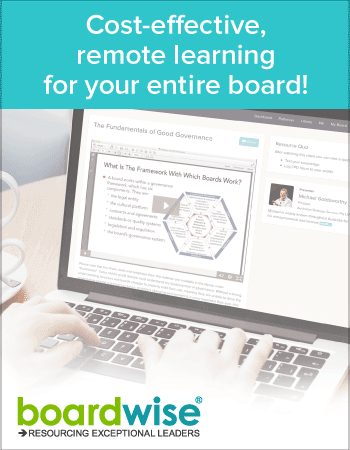Flying Minutes: Uses, Benefits and Risks of Circular Board Resolutions
-
meetings
Flying Minutes: Uses, Benefits and Risks of Circular Board Resolutions
Flying minutes, also known as circular resolutions, are a way for a board of directors to make decisions outside of their normal meeting cycle. These types of decisions can be important when time is of the essence or when a decision needs to be made before the next scheduled board meeting.
a way for a board of directors to make decisions outside of their normal meeting cycle.
The process of creating a flying minute is similar to that of a formal board resolution. The decision is documented in a written format that clearly states the proposed outcome and the names of those voting in favour of it.
Flying Minutes & Board Portals
In the past, flying minutes were often distributed via email or fax. However, with the advent of board portal software, such as Our Cat Herder, it has become much easier to create, distribute and track these types of decisions. Board portals provide a secure, online platform where board members can access and review documents, including flying minutes, in real-time. This eliminates the need for physical documents and allows for faster distribution and approval.
Board portals also provide a variety of other useful features such as the ability to hold virtual board meetings, manage board member information and track the progress of ongoing projects. This makes it an essential tool for any organisation looking to streamline its decision-making processes.
When creating a flying minute, it is important to ensure that it is clear, concise and easy to understand. It should document the decision, the rationale behind it, and any relevant details such as the date and time of the decision, the names of the board members who voted in favour, and any other relevant information.
Key Elements to Include
The key elements to include in a flying minute:
-
Title: The title should clearly state that it is a flying minute or circular resolution. This identifies it as a decision made outside of a regular board meeting.
-
Date: The date the flying minute is created and distributed to board members.
-
Decision: A clear statement of the decision being proposed. For example, “The board approves the purchase of Company XYZ for $1 million.”
-
Background: A brief explanation of the circumstances leading to the need for the decision and any relevant details.
-
Rationale: An explanation of why this decision is in the best interest of the company and shareholders.
-
Authority: Any references to bylaws, legal statutes or other regulations that are relevant or required.
-
Next Steps: Any actions required to implement the decision. This provides clarity on what needs to happen after the resolution is approved.
Once the vote has been passed or not:
- Voting Results: The names of board members voting in favour, against, or abstaining from the decision.
Flying Minute Protocols and Guidelines
It is also important to follow proper protocols and guidelines, such as complying with any legal or regulatory requirements. For example, if the decision requires a vote, the flying minute should specify the quorum and the number of votes required to pass the resolution.
Additionally, the process for creating and approving a flying minute may involve:
-
Drafting: The flying minute is drafted by a board member, corporate secretary, legal counsel or other authorised individual.
-
Review: The draft flying minute is reviewed by key stakeholders to ensure it is accurate, clear and follows proper protocols.
-
Distribution: The flying minute is distributed to all board members through secure board portal software or other appropriate channels.
-
Timeline: Board members are given a reasonable timeframe (e.g. 24-48 hours) to review the flying minute and submit their votes.
-
Voting: Board members vote to approve or reject the resolution within the designated timeline, with non-responses generally counted as votes in favour.
-
Recording: Once approved, the final flying minute, including voting results, is recorded in the organisations records.
-
Implementation: Any actions required to execute the decision are initiated.
-
Ratification: To formalise the decision, the flying minute is included in the agenda and ratified at the next board meeting.
Benefits of Flying Minutes
There are several benefits that flying minutes provide:
-
Speed: They allow timely decisions to be made without having to wait for the next board meeting. This is essential for time-sensitive matters.
-
Flexibility: Flying minutes provide flexibility to make decisions as needed, rather than being constrained to set meeting schedules.
-
Cost savings: Extra board meetings can be expensive in both time and money. Flying minutes minimise costs by enabling decisions remotely.
-
Responsiveness: Enables the board to respond quickly to changing business conditions that require immediate action.
-
Record keeping: Provides a formal record of the decision that has been made.
Risks and Limitations
However, there are also some limitations to be aware of:
-
Less discussion: By their nature, flying minutes involve less deliberation than in-person meetings. There is a risk decisions may be made without thorough consideration.
-
Technology dependence: Board members must have reliable access to required technology to receive and review flying minutes in a timely manner.
-
Difficulty revoking: Unlike meeting minutes which are approved at the next meeting, in some situations it can be harder to revoke flying minute decisions.
-
Perception of Less transparency: There can be a perception of less transparency when using flying minute decisions compared to those made during board meetings.
To mitigate the risks, it is important that flying minutes follow all governance requirements, allow reasonable time for review, and are ratified at subsequent board meetings.
Recording and Ratification
The flying minutes should be recorded and kept with the official records and approved in the next meeting of the Board. Maintaining thorough records ensures transparency and accountability.
Key steps include:
-
Recording: The final flying minute is recorded in the corporation’s minute book, records and board portal.
-
Approval: Flying minutes are included in the agenda and approved along with regular meeting minutes at the next board meeting.
-
Accessibility: In some cases flying minutes might be made accessible other stakeholders through “records available upon request” or other appropriate channels.
-
Compliance: Administrators ensure flying minutes comply with all relevant governance regulations related to board decisions and documentation.
Proper documentation provides validation of the decision and maintains an accurate history of board resolutions. This supports transparency for both regulators and stakeholders.
The Bottom Line
Flying minutes, also known as circular resolutions, provide an efficient way to capture board decisions outside of regular meetings. With the help of board portal software, they can be created and distributed quickly and easily, enabling timely decisions.
However, it is important to follow proper protocols and guidelines to ensure the resolutions are made legally, documented thoroughly, and transparent to shareholders. Maintaining detailed records and processes helps mitigate risks and preserves accountability. Flying minutes are a valuable governance tool when used responsibly.
Resources
Ensuring Your Board of Directors is Diligent
Who Should Control the Reporting of Information to the Board?
Frequently Asked Questions
What are flying minutes?
Flying minutes, also known as circular resolutions, are documents that record decisions made by a board of directors outside of regular board meetings. They allow timely decisions without having to wait for the next scheduled meeting.
When are flying minutes used?
Flying minutes are typically used when a decision is needed quickly and the next board meeting is too far away, or when an important opportunity or issue arises that can't wait. They allow flexibility to make decisions on an ad hoc basis.
What should be included in a flying minute?
A flying minute should include the date, decision being made, background details, voting results, names of directors in favour, and any next steps or actions required. Proper protocols and regulations should be followed.
How are flying minutes approved?
Flying minutes are distributed to directors through board software and typically require majority approval within a set timeline, usually 24-48 hours. Non-responses are generally counted as votes in favour.
Are flying minutes as valid as regular meeting decisions?
Yes, once properly approved and recorded, flying minutes carry the same legal validity as decisions made during regular board meetings. However, they should generally be ratified at the next board meeting.
-



